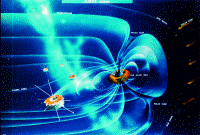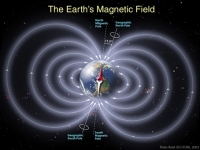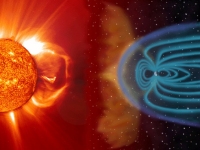Background Science
Earth's magnetic field lines
All magnetic objects produce invisible lines of force that extend between the poles of the object. Earth is similar to a giant bar magnet with magnetic field lines radiating from the south to the north magnetic pole. Charged particles become trapped on these field lines, forming the Earth's magnetosphere.
However, Earth's magnetic field lines are not symmetric with respect to its magnetic axis, unlike those of a bar magnet. The impact of a continuous stream of solar particles (the solar wind) causes the lines facing the Sun to be compressed. The field lines facing away from the Sun get stretched and elongated, forming the Earth's magnetotail. The bullet shaped magnetic bubble formed by the terrestrial magnetic field lines is called the Earth's magnetosphere. The magnetosphere extends into the vacuum of space, on average, from approximately 60 000 kilometres sunward, and trails out more than 300 000 kilometres away from the Sun in the magnetotail.
The regions of near-Earth space
The largely empty space between the planets is dominated by the solar wind - a stream of electrically charged particles (mainly electrons and protons) which are ejected at supersonic speeds by the Sun. Fortunately, the Earth's magnetic field is strong enough to protect our planet from this solar gale, usually preventing it from hitting the atmosphere or surface. However, a number of recognisable layers and boundaries can be observed in near-Earth space where the solar wind and Earth's magnetic field meet. These regions will be explored in great detail by Cluster.
 |
|
Artist's impression showing the |
The first sign of any interaction between the solar wind and Earth's magnetic field is a shock wave in space on the Sun-facing side of the Earth. This bow shock is rather like the sonic boom caused when a supersonic aircraft slows down and passes through the sound barrier. The Earth's bow shock is created when the supersonic solar wind is suddenly slowed as it approaches the planet's magnetic shield: the magnetosphere.
The edge of the magnetosphere is known as the magnetopause. When the Sun is more active, the increased pressure from the solar wind squashes the magnetosphere. At such times, the magnetopause is forced much closer to the Earth until it is only 35 000 kilometres above the planet instead of the average 60 000 kilometres.
However, there are two weak points in Earth's defences. These cusps occur above the planet's north and south magnetic poles. Particles from the solar wind which leak into the magnetosphere spiral down towards the Earth along magnetic field lines. When they strike atoms in the upper atmosphere, they cause the shimmering sheets of colour known as the auroras (northern and southern lights).


